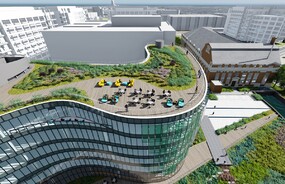Project Details
- Project Name
- The U.S. Department of Veterans Affairs Palo Alto (VAPA) Polytrauma and Blind Rehabilitation Center
- Location
- CA
- Architect
- The Design Partnership
- Client/Owner
- U.S. Department of Veterans Affairs
- Project Types
- Healthcare
- Project Scope
- New Construction
- Size
- 174,000 sq. feet
- Year Completed
- 2020
- Shared by
- Madeleine D'Angelo
- Project Status
- On the Boards/In Progress
- Cost
- $600,000,000
Project Description
This project won an award in the 2019 AIA/AAH Healthcare Design Awards
FROM THE AIA:
The new VA Palo Alto (VAPA) Polytrauma and Blind Rehabilitation Center is one of only five polytrauma centers in the country designed specifically to serve and enhance the patient rehabilitation experience of polytrauma, blind and visually impaired veterans. At 174,000 square feet, it is not only the largest federal rehabilitation facility but also the only center to house polytrauma and blind rehabilitation services under one roof.
The Center’s impactful approach to healing through design—where the environment itself is a tool for rehabilitation—provided the design team provided the team with multiple opportunities to improve the patient experience by designing for our senses—touch, movement, smell, taste, sight, hearing and balance. The evaluation of each design element against these human sensory metrics resulted in a more immersive and healing space for patients, staff and visitors alike. The Polytrauma and Blind Rehabilitation Center exemplifies equity by design—minimizing barriers that patients face to maximize the potential for successful rehabilitation. The design integrates the latest advances in accessibility, universal design, and rehabilitation practices, resulting in a healthcare facility that aims to not only enhance patient recovery during their rehabilitation journey but long after.
The Rehabilitation Center houses 24 polytrauma rehabilitation beds, 32 blind rehabilitation beds, and 12 polytrauma transitional rehabilitation beds. To create a more healing experience, the polytrauma patient rooms feature an abundance of natural light and non-institutional materials. A seamless transition between all materials ensures that surfaces require minimal effort to negotiate. Railings circling the corridors encourage movement, but the building also encourages ‘mobility without crutches,’ balancing accessibility with real-world conditions. Each design feature reinforces and supports the physical and occupational therapy and training. Staff performance was another important consideration. Our designers worked closely with staff to determine their unique needs, resulting in the clarification and enhancement of circulation systems, the creation of calming spaces for patients and staff, and a flexible modular approach to better address future changes in rehabilitation practices. With staff guidance, our design team embraced functional, impactful design solutions in lieu of overstimulating decor and amenities.
Project Credits:
Project: The U.S. Department of Veterans Affairs Palo Alto (VAPA) Polytrauma and Blind Rehabilitation Center
Architects: SmithGroup and The Design Partnership
Acoustics: Charles M. Salter Associates, Inc.
Electrical Engineer: Guttmann & Blaevoet | Cammisa + Wipf
Mechanical Engineer: Capital Engineering Consultants, Inc.
Plumbing Engineer: Capital Engineering Consultants, Inc.
Structural Engineer: Degenkolb Engineers
Geotechnical: Treadwell & Rollo, a Langan Company
Interiors: SmithGroup
Landscape Architects: Keller Mitchell & Co. | Royston Hanamoto Alley & Abey
Planning: SmithGroup
Signage: Kate Keating Associates
Technology: TEECOM

































